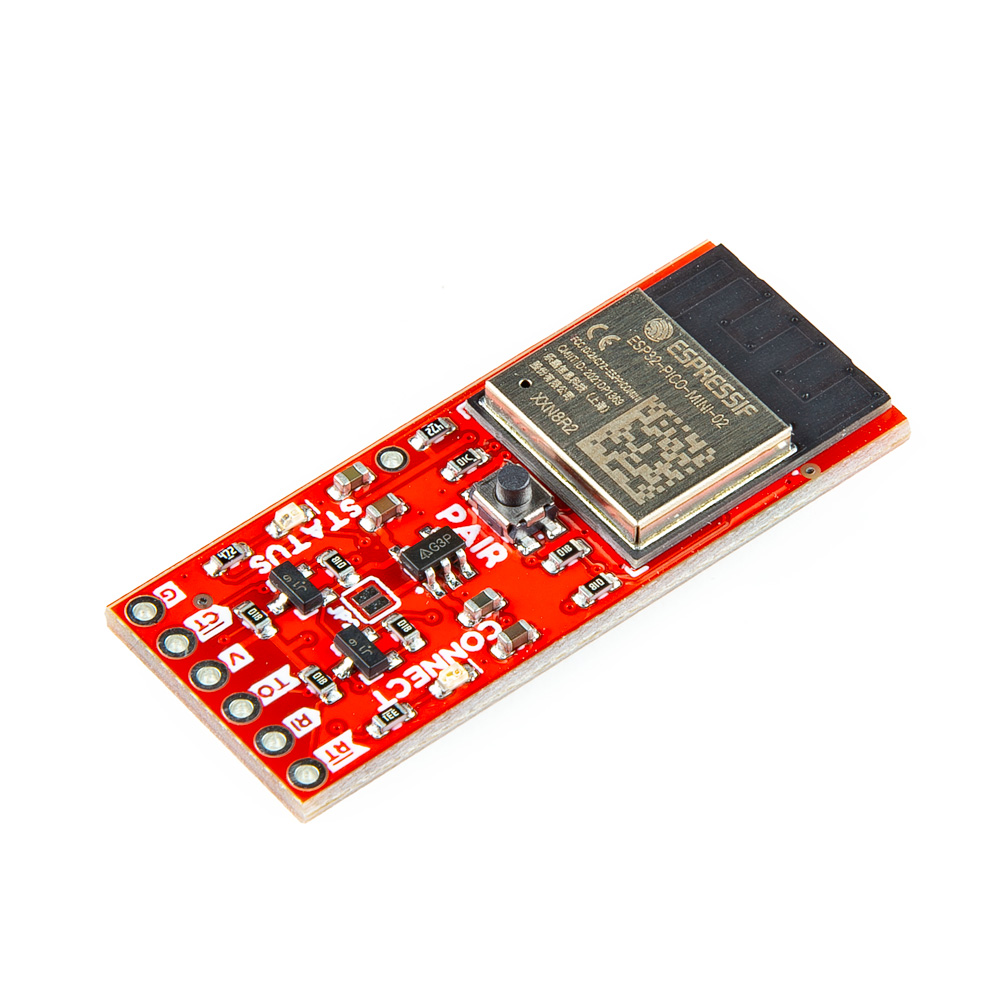SparkFun BlueSMiRF v2
The SparkFun BlueSMiRF v2 is a wireless Bluetooth® serial link. These boards work as a wireless serial UART pipe and are a great wireless replacement for serial cables. Simply pair, connect, and transmit serial data between your TX/RX lines! Any serial stream from 2400 to 921600 baud can be passed seamlessly between two devices.
Duplex transmissions up to 921600bps are supported. What does this mean? You can throw a book at each BlueSMiRF, which will correctly buffer, transmit, and deliver the data streams, byte perfect, to both radios.
BlueSMiRF v2 has a multitude of exciting improvements over the original. The BlueSMiRF pinout is the same as previous Bluetooth Mates and USB-to-serial converters (i.e., FTDI, CH340, etc.), making it extremely easy to hook up to many common Arduino development boards and high-precision GNSS breakout boards. The board can be connected directly with an Arduino Pro, Pro Mini, LilyPad Arduino 328 Main, ZED-F9P, ZED-F9R, UM980, SerLCD, or any board with a standard 6-pin serial connector. We broke out the pins to the 1x6 header for this version of the board. You'll need to either solder a 1x6 female header or striped wires to the PTHs before being able to connect to another device. The SparkFun BlueSMiRF v2 is perfect for short-range applications up to 100ft (33m) indoors that require easy to setup, point-to-point communication.
A BlueSMiRF can be connected to a phone or computer to view data or remote control easily. Two BlueSMiRFs can also be easily connected using the onboard PAIR button. If needed, this button can be disabled by cutting the jumper on the back of the board.
We've designed the BlueSMiRF to be remotely configured from a phone using a serial terminal app. Changing the settings, such as the baud rate, flow control, and LED mode, is easily done using the simple AT command set. Additionally, Over The Air (OTA) updates using WiFi allow easy in-field firmware updates as new features are released.
The BlueSMiRF v2 has an on-board voltage regulator to power between 3.3V and 5V. Logic level shifting circuitry is included on all pins to be 3.3V to 5V tolerant. Note that you will need an RS232 to TTL converter for higher voltages. A jumper on the top of the board is also included to bypass the voltage regulator. Two built-in LEDs indicate when the BlueSMiRF is connected and when there is serial UART traffic.
Note: Bluetooth® classic (Serial Port Profile or SPP) is primarily supported. This Bluetooth protocol is supported on Android phones, most desktops, and laptops. BlueSMiRF also supports the BLE protocol, available on all Apple phones.
- Espressif's ESP32-PICO-MINI-02 Module with Built-in PCB Antenna
- Serial Bluetooth® Point-to-Point Communication
- Bluetooth Protocols Supported
- Serial Port Profile (SPP)
- Bluetooth Low Energy (BLE)
- Firmware Over-the-Air (OTA) Updates via 2.4GHz WiFi
- Recommended Input Voltage: 3.3V to 5V
- Current & Power Consumption @ 3.3V
- Idle: 72mA / 238mW
- Connected with no Serial Traffic: 75mA / 248mW
- Constant Duplex Serial Traffic: 140mA / 462mW
- AP2112K 3.3V/600mA Voltage Regulator
- Logic Level Converters on all pins
- Standard Serial Port Broken Out to PTHs
- RTS/RXI/TXO/VCC/CTS/GND
- PTH
- Reset
- Button
- Pair
- LEDs
- CONNECT
- STATUS
- Jumpers
- 3.3V Bypass Jumper (JP2)
- Pair Button (BTN)
- Board Dimensions
- 44.2mm x 15.22mm
- Weight: 3g
- Schematic
- KiCad Files
- 3D Model
- Board Dimensions
- Hookup Guide
- Datasheet (ESP32-PICO-MINI-02)
- Firmware
- GitHub Hardware Repo
SparkFun BlueSMiRF v2 Product Help and Resources
Comments
Looking for answers to technical questions?
We welcome your comments and suggestions below. However, if you are looking for solutions to technical questions please see our Technical Assistance page.
Customer Reviews
4 out of 5
Based on 1 ratings:
Shamefully it didn't work
I read a review on the internet how the silver version of this could be paired with the mindwave mobile head set. Shamefully putting the headset into pairing mode is no longer supported with MindWave Mobile 2, so could not use the button to pair. And with your new V2 of the silver you cannot enter a Mac address, so left me completely stuck and now looking to find an alternative.








U.FL option available? Is it planned to offer this board with U.FL connector (ESP32PICOMINI02U module), too?
A fine idea! It was not on our roadmap but I'll add it.
Thank you so much for this excellent good news! While there are trillions of BLE only modules on the market now, less and less SPP products became available, and most of BR/EDR or dual-mode modules are assembled with on-board chip antenna or only a simple copper line... :-( But good old SPP is still the only non-proprietary way for typical serial byte streaming, for instance especially the NMEA transmitting from external GNSS receivers (including multi-band and RTK hardware) into Windows and Android devices, when GIS apps can import external NMEA sources but doesn't have any proprietary BLE library for quasi-serial connections! And of course, it's always much better to assemble ruggedized GNSS devices with a serious Bluetooth antenna (screwed and providing much more RF performance)... That's why I'm really looking forward to get the ESP32PICOMINI02U option!